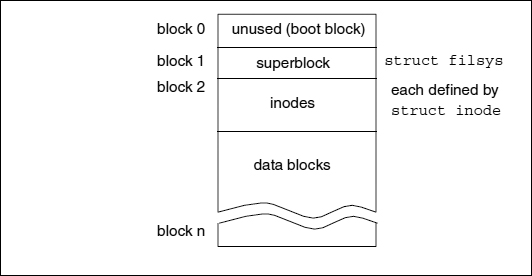The UNIX Filesystem
Before describing how the different kernel structures work together, it is first necessary to describe how the original UNIX filesystem was stored on disk. Figure 6.1 shows the layout of various filesystem building blocks. The first (512 byte) block was unused. The second block (block 1) held the superblock, a structure that holds information about the filesystem as a whole such as the number of blocks in the filesystem, the number of inodes (files), and the number of free inodes and data blocks. Each file in the filesystem was represented by a unique inode that contained fields such as:
i_mode. This field specifies whether the file is a directory (IFDIR), a block special file (IFBLK), or a character special file (IFCHR). Note that if one of the above modes was not set, the file was assumed to be a regular file. This would later be replaced by an explicit flag, IFREG.
i_nlink. This field recorded the number of hard links to the file. When this field reaches zero, the inode is freed.
i_uid. The file's user ID.
i_gid. The file's group ID.
i_size. The file size in bytes.
i_addr. This field holds block addresses on disk where the file's data blocks are held.
i_mtime. The time the file was last modified.

Figure 6.1 The on-disk layout of the first UNIX filesystem.
i_atime. The time that the file was last accessed.
The i_addr field was an array of 8 pointers. Each pointer ...
Get UNIX Filesystems: Evolution, Design, and Implementation now with the O’Reilly learning platform.
O’Reilly members experience books, live events, courses curated by job role, and more from O’Reilly and nearly 200 top publishers.

